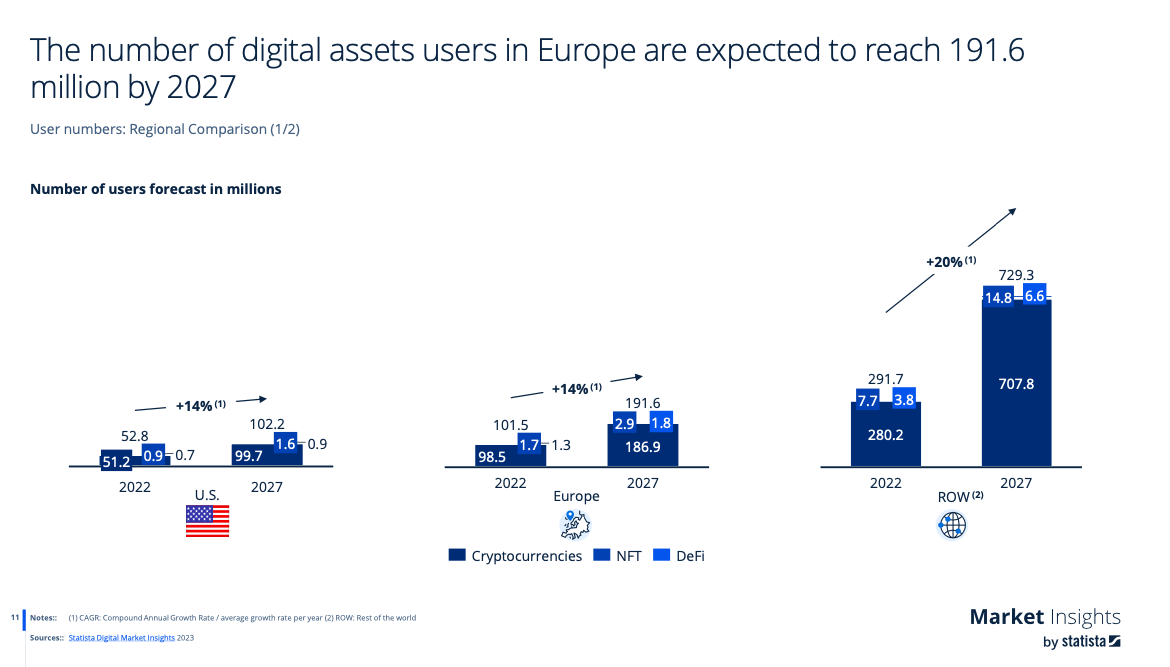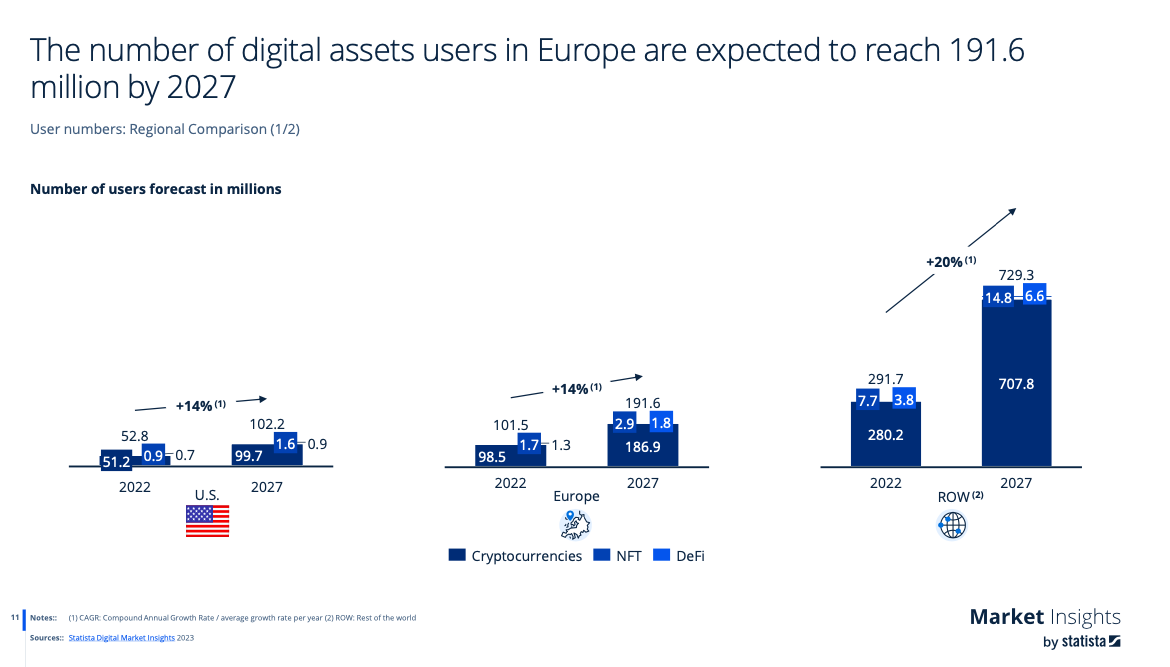
Last updated:
| 5 min read

Russia and the USA are expected to take the lead in crypto adoption, according to a new report published on Statista called Digital Assets: Market Data & Analysis.
According to the figures, the number of crypto users in Russia could reach 38.5 million by 2027. That’s a 15% increase year-on-year (yoy) from the 19.3 million crypto users in 2022. This percentage is the highest average growth rate for any of the countries or regions surveyed in the report.
That means Russia’s total number of crypto users, which at present exceeds high numbers posted by UK, Japan, Canada and Germany, will go on being the second highest in the world for cryptocurrencies, ahead of every European and Asian rival and second only to the U.S..

Over the Pacific, the US recorded a staggering 52.8 million crypto users in 2022, a figure which exceeds Russia’s projected 2027 figure by a fraction over 37%, indicating the world-leading scale of adoption in both the former Cold War rivals.
However, adoption in the US will skyrocket too, with a near doubling over five years to a projected 102.2 million users by 2027. Altogether, the year-on-year growth rate for the US between 2022 and 2027 is 14%, which is in line with Japanese and European projections but lags 1% behind Russia.
The number of European crypto users in 2022 was 101.5 million; this looks set to blow up to 191.6 million by 2027.
The rest of the world will see exponential growth in crypto adoption. At present, the total number of users across all the countries that are not USA or continental Europe is 291.7 million. That figure will mushroom 20% year-on-year to peak at 729.3 million in 2027.

Cryptocurrencies, NFTs, or DeFi?
One interesting point to observe is how the popularity of NFTs and Decentralized Finance protocol users varies by region. NFTs are undoubtedly more popular in the USA than any other region, with 0.9 million NFT users in 2022. That figure is expected to rise sharply to 1.6 million by 2027.
Hardly anywhere else takes NFTs nearly so seriously, though. The closest contender to the US, Russia, at present has a third of the NFT users of its rival. The projections for 2027 broadly reflect a proportionate increase as the number of Russian NFT holders doubles from 0.3 million to 0.6 million.
While people think of America as the land of supersized highways and Mcdonald’s meals, continental Europe far exceeds it in metrics for NFT and DeFi use, although this remains proportionate to the overall number of users in both regions, with Europe nearly doubling the States and projected to comfortably maintain the lead by 2027.
In general, the figures are positive for all aspects of crypto. The report highlights expectations that tokens (both fungible and non-fungible) and dapps will remain a thriving part of the broader cryptocurrency and blockchain ecosystem in the post-regulation landscape.
How Regulations Drive Russian Crypto Adoption
This brings us to one key area that affects countries’ attitudes towards crypto, and by extension, their adoption level, namely: regulation.
So, understanding Russia’s lead on crypto should be simple when we examine the context. Singapore research firm TrippleA estimated about 17.3 million Russians owned crypto in early 2021. The figure represented 12% of the population at the time. It grew by 2 million the following year.
The lofty numbers are hardly surprising in a country where 46% of its internet users pay for goods and services using e-money, $16.8 billion of which is on-chain, according to 2022 figures.
However, Russia’s crypto fans have hard a nervy ride. The Kremlin wasn’t always so accommodating. In January 2022, the Russian central bank published a public and industry consultation paper calling for tight oversight on crypto and an outright ban on a lot of crypto-related activities in the territory, including mining. This changed with the invasion of Ukraine.
Now, Russia is taking a flexible approach. This week, government ministers have been discussing a new draft bill submitted by miners that aims to recognise the activity as a form of entrepreneurship. The bill has support from a swathe of lawmakers but lacks a final seal of approval from the Ministry of Industry and Trade.
But on the whole, the Russian government has been reserved about cryptocurrencies. While cryptocurrencies present a potential avenue to help Russian citizens to evade US sanctions, the authorities have been focusing their energy instead on the digital ruble.
How Regulations Drive Crypto Adoption in US
The regulation narrative will also continue to drive adoption in the US, albeit for different political and geopolitical reasons.
The number one driver of adoption in the USA currently is the spot Bitcoin ETF narrative. ETFs are investment vehicles from funds that buy and hold Bitcoin to create and sell shares for their funds on exchanges.
The industry was looking to US approval of spot Bitcoin ETFs to be the number one driver of institutional and family office adoption of crypto, because they provide a regulated means for anyone with a brokerage account to buy and hold Bitcoin to exploit its potential gains.
Many regions legalised ETFs in recent years, including Canada and Europe. However, the prospect of a US ETF looked distant because the regulator responsible for approving one, the Securities and Exchange Commission (SEC), has pursued an openly anti-crypto agenda since Chairman Gary Gensler took office in 2021 and started a crackdown by suing multiple actors in the industry, aka regulation-by-enforcement.
Last year, things changed. A federal court overturned a ruling by the SEC that denied crypto-friendly asset manager Grayscale’s application to convert its Bitcoin trust into an ETF. The Judge ruled the SEC’s rejection “arbitrary and capricious”.
Fast forward to 2024 and the SEC conceded 11 spot Bitcoin ETFs to the industry. They have been some of the most successful ETF launches in history, netting to date over $11.7 billion in inflows.
Elsewhere in Washington, fierce debates have ignited around a proposed bill by anti-crypto lawmakers that the industry says puts far too stringent reporting requirements on crypto.
In general, the US may be far behind the EU and Canada in terms of regulatory clarity, but crypto’s Stateside believers are likely to hold their dominating grasp on the world market in the short term.
Register at Binance